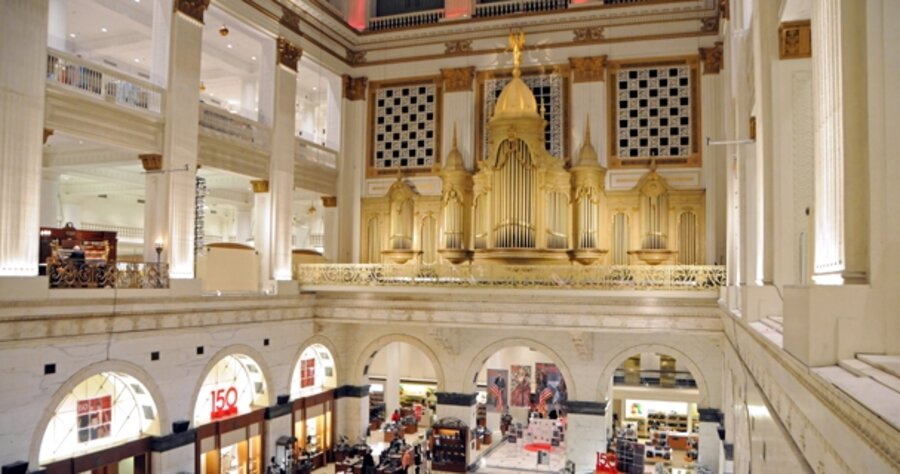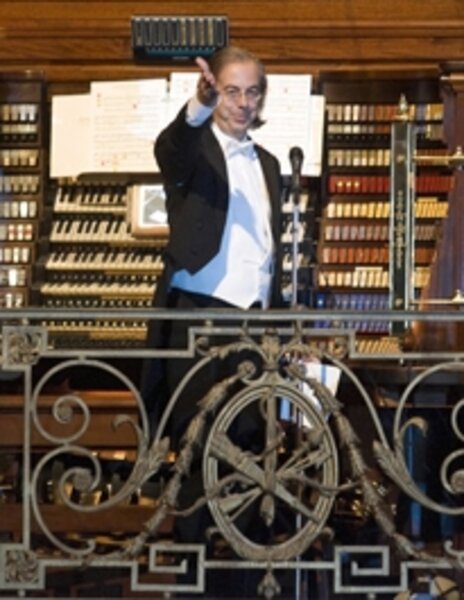World’s largest working pipe organ is in ... Macy’s
Loading...
| Philadelphia
Philadelphia
When you see the Wanamaker organ soar heavenward, you want to look around for the rest of the cathedral. When its sound makes pillars tremble, you know it speaks for the powers above. But where stained glass windows should be – there is ladies apparel. In the would-be pews, people are trying on boots. And that scent wafting through the air is not votive candles, it’s Chanel No. 5.
Wait. This is no church. This is ... Macy’s?
Here, occupying prime retail space, there are nearly 30,000 organ pipes in chambers towering up through seven floors, making the Wanamaker the largest operating pipe organ in the world. For precious square footage to be given over thus is rare. Even modest organs tend to be located not in stores but in churches, private homes, or municipal buildings; built by the Los Angeles Art Organ Company, the Wanamaker is one of only two known department-store organs in the world.
As spectacular as the instrument is, so, too, is the space it inhabits. The 1911 masterpiece of a building designed by Daniel Burnham, a pioneer of urban planning and skyscraper architecture, is like a renaissance palace. A national historic landmark, it covers a city block, running from Chestnut Street to Market, from 13th to Juniper, and encompassing a 150-foot-high center court lush with decorative plaster, laced with arches, and rich with marble. The Grand Court, open to shoppers peering from the floors above, is the space that retail pioneer John Wanamaker sought to fill with the sounds of the organ he brought here from the 1904 St. Louis World’s Fair.
That Mr. Wanamaker should bring such a treasure into a mere marketplace was typical of his character. At this, the flagship of the 17-store chain that bore his name, Wanamaker introduced the concept of the modern department store as he evolved from a men’s clothing seller into a pioneer of truth in advertising, the money-back guarantee, the in-store restaurant, in-store electricity and phone, and free medical care for employees.
Wanamaker’s son Rodman shared his father’s passion for the organ, and more pipes were added over the years so the music could better fill the massive court. But after Rodman died in 1928, interest in it waned. It fell into disrepair and conditions declined into the 1980s and beyond, as the Wanamaker chain was sold and resold several times. By the time it became Lord and Taylor in 1997, barely 20 percent of the pipes worked. Yet the instrument never went entirely silent. It has been played every business day since it was installed in 1911.
Finally Macy’s, with a Wanamaker-like love of the big show, embraced the beast when it took over the store two years ago, restoring it to its full capacity – even moving the orchestral division of pipes from exile in a remote corner of the store to a location where they are properly heard (which happens to be expensive office space now).
Last month when the Philadelphia Orchestra visited for a joint Saturday evening benefit concert, part of a Macy’s 150-year anniversary program, the pristine organ showed her stuff. Together, the organ and orchestra, with Grand Court organist Peter Richard Conte at the console, performed Joseph Jongen’s “Symphonie Concertante,” an organ-orchestra piece written for the Wanamaker organ back in 1926 but never played on the instrument for which it was commissioned. The orchestra’s Rossen Milanov, who conducted, saw the concert as “a once-in-a-lifetime chance,” the first time the orchestra and organ played together since the days when the great conductor Leopold Stokowski would bring his orchestra to Wanamaker’s in the 1920s.
The Wanamaker is a symphonic organ famous for its ability to sound like an orchestra. Indeed, last month, when they played together and the organ could be mistaken for the Philadelphia Orchestra, it was taken as validation that the organist, curators, technicians, and owners had succeeded in bringing the instrument to a potential never before achieved in the Grand Court.
The court itself is a mecca to music lovers from around the world, who’ve been known to dash directly there from the airport to avoid missing a concert. And the locals? They might be more likely to consider the organ background noise as they head for the court’s huge eagle statue, the customary center-city meeting place for Philadelphians.
More than one shoe salesman has been known to yell up to the organist at the second floor console to lower the volume, and one organist is said to have played the tune to “Keystone Cops” when he spotted security chasing a shoplifter on the floor below. “The kid had the dramatic timing to run the other way” when the whistle blew, recalls Ray Biswanger, of the nonprofit Friends of the Wanamaker Organ, which is dedicated to its preservation.
Organist Peter Richard Conte confesses to using the instrument as a musical weapon once when store security asked him to play “very, very loudly” when a noisy group of protesters arrived intent on unfurling nasty banners in the Grand Court. “I blasted them out,” he recalls, smiling.
Wrapped in the gleaming mahogany console for one of his two daily concerts, Mr. Conte indulges the organ’s ability to sound like an orchestra as he plays music he has transcribed for the organ from orchestral compositions – the better to take advantage of its famous sound palette: Elgar’s “Enigma Variations,” Wagner’s “Liebestod,” Bernstein’s overture to Candide.
“Why not give her what she likes?” he asks of the organ he calls “Baby.” Each concert includes some crowd-pleasers, and he recalls fondly looking over the rail once and seeing a woman dancing to his Strauss waltz in the the court below.
Curator Curt Mangel recalls another shopper happily singing along with music from “West Side Story” while she browsed.
At Christmas, the organ takes center stage for the store’s famous light show, which also had fallen on hard times of late. So the tradition-loving Macy’s refurbished the light show as well, hiring Julie Andrews to redo the narration. And Macy’s brought in a beloved life-size Dickens village that disappeared from the city’s holiday tradition scene when its home at the Strawbridge & Clothier store down the street closed.
“We are entertainment. Shopping is theater,” says Bill Schermerhorn, creative director of Macy’s parade and entertainment arm. “John Wanamaker was a showman. I think he would very much approve.”
The economics of retail have repeatedly shrunk John Wanamaker’s grand store (the nine original shopping floors are now three), but the organ’s popularity continues to expand. Conductor Milanov, a center city resident, makes it a point to walk through the court to hear “one of the few instruments in the world with the capability for playing so many different sound colors.” Another music lover, Edward Real, a hurricane Katrina refugee who happened upon the organ while shopping one day, calls it “wonderful.”
For Mr. Biswanger, the preservationist, the instrument’s true glory emerges when the store is closed and the background noise gone. “It’s one of those rare things that makes a lifetime impression.” Conte, only the fourth Grand Court organist in the store’s history, doesn’t mind the imperfection of the everyday: “Part of the charm is the meeting of people from all over the world – folks from Europe making a pilgrimage [to hear the organ] and people who came in to buy women’s shoes.” That the organ he has played for 20 years should find such an adoring owner, he calls “the miracle on Chestnut Street.”






